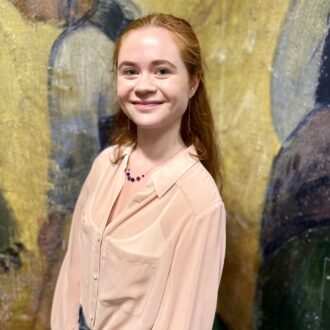A Subversive History of England’s ‘National Church’: Westminster Abbey, 1399-1603
Supervised by Dr Tom Nickson
Funded by The Courtauld Scholarship and het Cultuurfonds
My PhD explores how the erection of tombs, screens, chapels and temporary furnishings transformed the topography of Westminster Abbey between 1399 and 1603. I will interrogate how these privileged spaces catered to their elite patrons whilst marginalising others. Bridging the medieval and early modern periods, I will study the Abbey’s conversion at the Reformation from a royal Benedictine monastery into an Anglican church, focusing on how the nobility appropriated chapels as private burial sites. Such a study is only possible thanks to the exceptional survival of written and material evidence from this period in the Abbey’s history, and I will consider the extent to which England’s ‘national church’ can serve as a model for understanding transformations in other abbeys and churches in England and beyond. This project also redresses major gaps in an otherwise heavily studied building: the Abbey’s relationship with the Crown during the Wars of the Roses, the impact of the Reformation, and the patronage and embodied experiences of its monastic community, pilgrims and local citizens.
Education
- PhD in History of Art, The Courtauld (2023 – 2026)
- Palaeography and Diplomatic, Institute of Historical Research (2023 – 2024)
- Late Medieval and Renaissance Latin, Intermediate, The Warburg (2023 – 2024)
- MA History of Art, The Courtauld (2021 – 2022)
Special Option – ‘England, Europe and Beyond: Art, Identity, Trade & Politics in the Middle Ages’, supervised by Dr Tom Nickson
Dissertation (high distinction) – ‘In every of these, I suppose, this Countess was noble’: Constructing Lady Margaret Beaufort’s Memory at Westminster Abbey
- BA History of Art, The Courtauld (2018 – 2021)
Sam Fogg Prize for Best Assessed Essay on a Medieval Topic – Shit Happens: Scatological Imagery in a Cloister Boss, Psalter and Misericords from Norwich Cathedral in the Fourteenth and Fifteenth Centuries
- BA Liberal Arts and Sciences, Amsterdam University College (2015 – 2018)
Conferences, Talks and Publications
- ‘‘In every of these, I suppose, this Countess was noble’: Constructing Lady Margaret Beaufort’s Memory at Westminster Abbey’, 11th Annual ARDS Conference on Mixed Media Medieval and Renaissance Sculpture (12 December 2024)
- ‘Beyond the Gallery: Medieval Art in Context’, The Courtauld Summer School (24 June, 1 and 8 July 2024)
- Chair, Medieval Postgraduate Colloquium: Authority and Identity in the Middle Ages, The Courtauld (15 March 2024)
- Sophia Dumoulin, ‘Gothic Once More?: Christopher Wren’s Classicising Refurbishment and Walter Godfrey’s Post-War Restoration of the Temple Church, London’, Immediations 20 (2023)
Relevant Work Experience
- Tour Guide, The Courtauld Gallery (2024 – now)
- Teaching Assistant, ‘Foundations’, The Courtauld (Autumn 2024)
- Associate Editor, Immediations 21 (2024)
- Research Assistant, Westminster Abbey (2023 – 2024)
- Short Courses Events Officer, The Courtauld (2022 – 2023)
Grants and Awards
- Cultuurfonds Scholarship for a PhD in the History of Art
- Courtauld Scholarship for a PhD in the History of Art
- Barrie Dobson Scholarship to attend the Harlaxton Symposium (12 – 15 August 2024) | award for best PGR/ECR presentation at the Symposium
- Scholarship to attend the British Archaeological Association’s summer conference in Pembrokeshire (15 – 19 July 2024)
- Sam Fogg Prize for Best Assessed Essay on a Medieval Topic in BA History of Art, Year 3
Research Interests
- Westminster Abbey
- Medieval visual culture
- Embodied experiences of medieval architecture
- Art and politics
- Self-fashioning and identity making
- Tomb sculpture
- Antiquarianism
